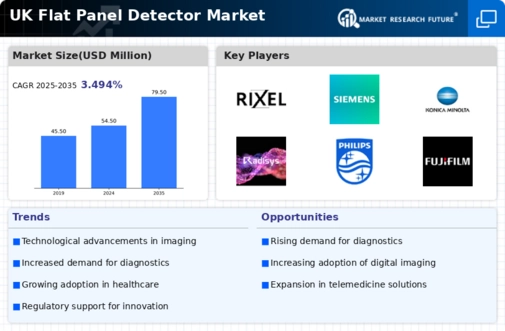Rising Healthcare Expenditure
The flat panel-detector market in the UK is experiencing growth due to the increasing healthcare expenditure. The UK government has been investing significantly in healthcare infrastructure, which includes advanced imaging technologies. In 2025, healthcare spending is projected to reach approximately £200 billion, with a notable portion allocated to diagnostic imaging. This investment is likely to enhance the adoption of flat panel detectors in hospitals and clinics, as these devices provide superior image quality and efficiency. Furthermore, the demand for early disease detection and improved patient outcomes drives the need for advanced imaging solutions. As healthcare budgets expand, the flat panel-detector market is expected to benefit from this trend, leading to increased sales and technological advancements in the industry.
Increased Focus on Patient Safety
Patient safety has become a paramount concern in the UK healthcare system, influencing the flat panel-detector market. The emphasis on minimizing radiation exposure during imaging procedures has led to a shift towards flat panel detectors, which are known for their lower dose requirements compared to traditional systems. Regulatory bodies are advocating for technologies that enhance patient safety, and as a result, healthcare providers are more inclined to invest in flat panel detectors. This focus on safety not only aligns with regulatory expectations but also enhances the overall quality of care. Consequently, the flat panel-detector market is likely to see increased demand as facilities prioritize patient safety in their imaging practices.
Expansion of Telemedicine Services
The expansion of telemedicine services in the UK is contributing to the growth of the flat panel-detector market. As healthcare providers increasingly adopt remote consultation and diagnostic services, the need for high-quality imaging solutions becomes critical. Flat panel detectors facilitate the transmission of high-resolution images, enabling healthcare professionals to make informed decisions remotely. The UK government has been promoting telehealth initiatives, which have gained traction among patients and providers alike. This trend suggests that the flat panel-detector market may experience a boost as more healthcare facilities integrate these technologies into their telemedicine offerings, thereby enhancing accessibility and efficiency in patient care.
Surge in Diagnostic Imaging Demand
The flat panel-detector market is witnessing a surge in demand for diagnostic imaging services across the UK. With an aging population and a rise in chronic diseases, the need for accurate and timely diagnostics is paramount. The NHS has reported a steady increase in imaging procedures, with an annual growth rate of around 5%. This trend indicates a growing reliance on advanced imaging technologies, including flat panel detectors, which offer enhanced resolution and reduced radiation exposure. As healthcare providers strive to meet the increasing demand for diagnostic services, the flat panel-detector market is likely to expand, driven by the need for efficient and reliable imaging solutions in clinical settings.
Technological Integration in Medical Devices
The integration of advanced technologies into medical devices is a key driver for the flat panel-detector market. Innovations such as artificial intelligence (AI) and machine learning are being incorporated into imaging systems, enhancing diagnostic accuracy and workflow efficiency. In the UK, hospitals are increasingly adopting these technologies to streamline operations and improve patient care. The flat panel-detector market stands to benefit from this trend, as these detectors are essential components of modern imaging systems. The potential for improved diagnostic capabilities and reduced operational costs may lead to a higher adoption rate of flat panel detectors in various healthcare facilities, thereby propelling market growth.





















Leave a Comment